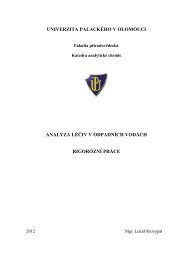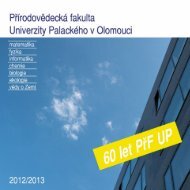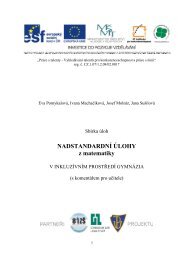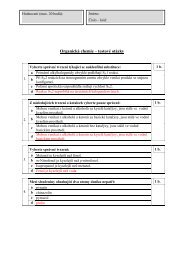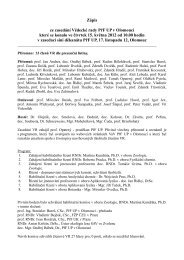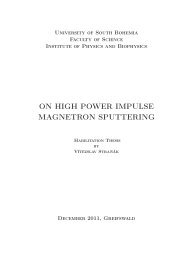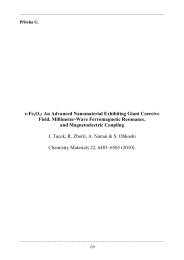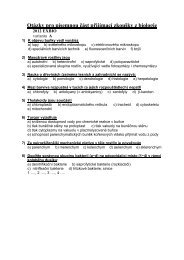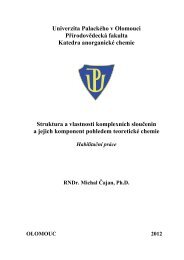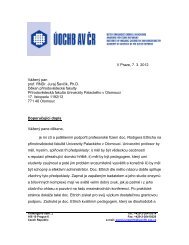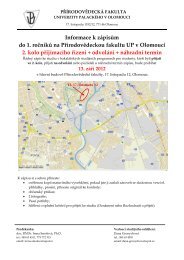A comparative structural analysis of direct and indirect shoot ...
A comparative structural analysis of direct and indirect shoot ...
A comparative structural analysis of direct and indirect shoot ...
Create successful ePaper yourself
Turn your PDF publications into a flip-book with our unique Google optimized e-Paper software.
4206 Illéš et al.<br />
Fig. 5. Changes <strong>of</strong> cortical cell membrane potential (E m ) after treatment<br />
with 50 lM AlCl 3 . E m depolarized rapidly (within 2 min) after aluminium<br />
application; depolarization was more extensive in the cells <strong>of</strong> distal<br />
transition zone (DTZ) than in the proximal transition zone (PTZ). After<br />
removing aluminium, E m in the PTZ completely repolarized within 3 min,<br />
while in the DTZ within 10 min (A). After 30 min aluminium treatment,<br />
the complete repolarization <strong>of</strong> E m occurred within 6 min in the cells <strong>of</strong><br />
PTZ <strong>and</strong> within 14 min in the DTZ (B). Representative <strong>of</strong> 24 seedlings<br />
per treatment.<br />
was fully reversible, which was consequently followed by<br />
recovery <strong>of</strong> root growth (data not shown).<br />
Internalization <strong>and</strong> accumulation <strong>of</strong> aluminium within<br />
endosomal/vacuolar compartments<br />
The dynamics <strong>of</strong> aluminium internalization was monitored<br />
in the root cells <strong>of</strong> Arabidopsis seedlings 2 d after germination.<br />
The intact roots were treated with 50 lM AlCl 3 for<br />
30 min, washed <strong>and</strong> stained with morin. After washing out<br />
morin, the seedlings were kept in control medium for recovering<br />
<strong>and</strong> the time-course <strong>of</strong> aluminium internalization in the<br />
living root apices could be observed with a confocal microscope<br />
for 3 h. In cells <strong>of</strong> meristem <strong>and</strong> DTZ, aluminium was<br />
located exclusively in the apoplast during the first 20 min<br />
<strong>of</strong> recovery (after aluminium removal; Fig. 6A). From then<br />
on, it was internalized into the cells. A first detectable diffuse<br />
fluorescence signal <strong>of</strong> morin-stained aluminium in the cytoplasm<br />
appeared after 60 min (Fig. 6B). Aluminium further<br />
proceeded into roundish structures with blurred edges, <strong>and</strong><br />
2 h <strong>and</strong> 30 min after the end <strong>of</strong> treatment it was located in<br />
vacuole-like structures <strong>of</strong> different size with clearly defined<br />
boundaries. In the cytoplasm the signal became weaker, in<br />
the cell walls it remained present (Fig. 6C). After 3 h <strong>and</strong> 30<br />
min, these cells accumulated aluminium almost exclusively<br />
in the vacuole-like compartments (Fig. 6D).<br />
The assumption that the target compartment <strong>of</strong> aluminium<br />
sequestration in the cells is the vacuole was confirmed<br />
by FM4-64, the dye widely used for labelling the plasma<br />
membrane, endocytic membranous compartments <strong>and</strong><br />
tonoplast (Betz et al., 1996; Geldner, 2004; Ovečka et al.,<br />
2005; Šamaj et al., 2005). Accumulation <strong>of</strong> aluminium<br />
was shown in the cells <strong>of</strong> root developmental zones that,<br />
as evident from the previous experiments, revealed different<br />
sensitivity to aluminium (Fig. 5). In the meristematic cells<br />
(Fig. 7A) <strong>and</strong> in the cells <strong>of</strong> the distal portion <strong>of</strong> the transition<br />
zone (Fig. 7B), aluminium was internalized rapidly<br />
<strong>and</strong> accumulated into the vacuolar compartments within<br />
2 h <strong>and</strong> 50 min <strong>of</strong> recovery. Tonoplast was labelled red with<br />
FM4-64 whereas the aluminium-containing lumen <strong>of</strong> the<br />
vacuoles was stained green with morin (Fig. 7A, B).<br />
In the cells <strong>of</strong> the proximal portion <strong>of</strong> the transition zone,<br />
there was no prominent accumulation <strong>of</strong> aluminium even<br />
3 h 10 min after aluminium deprivation (Fig. 7C). Moreover,<br />
aluminium did not enter vacuoles neither in the proximal<br />
portion <strong>of</strong> the transition zone nor in the elongation<br />
zone, it could only be detected in the apoplast. This indicates<br />
that after the removal <strong>of</strong> free aluminium ions from the medium,<br />
residual aluminium bound to the cell wall can be internalized<br />
into endosomal compartments <strong>and</strong> vacuoles <strong>of</strong><br />
living cells <strong>of</strong> the meristem as well as <strong>of</strong> the distal portion<br />
<strong>of</strong> the transition zone. On the contrary, in the less sensitive<br />
cells <strong>of</strong> the proximal portion <strong>of</strong> the transition zone, as well as<br />
in the elongation region (data not shown), cell wall-bound<br />
aluminium is not internalized <strong>and</strong> remains located in the<br />
apoplast.<br />
Effects <strong>of</strong> aluminium on endosomal behaviour<br />
After 10 min exposure <strong>of</strong> roots, FM4-64 strongly labelled<br />
cross-walls <strong>of</strong> the cells as well as the early endosomes<br />
(Fig. 8A; Voigt et al., 2005). When such cells were exposed<br />
to brefeldin A (BFA), the early endosomes aggregated<br />
into the so-called BFA-induced compartments (Fig. 8B;<br />
Šamaj et al., 2004, 2005). Aluminium treatment prevented<br />
formation <strong>of</strong> such BFA-induced compartments (Fig. 8C, D),<br />
suggesting that early endosomes, involved in aluminium<br />
internalization, were affected.<br />
Effects <strong>of</strong> aluminium on NO production<br />
NO-specific DAF-2DA labelling showed spatial distribution<br />
<strong>of</strong> NO production in cells <strong>of</strong> control root tips (Fig. 9A)<br />
<strong>and</strong> local changes <strong>of</strong> this distribution induced by aluminium




